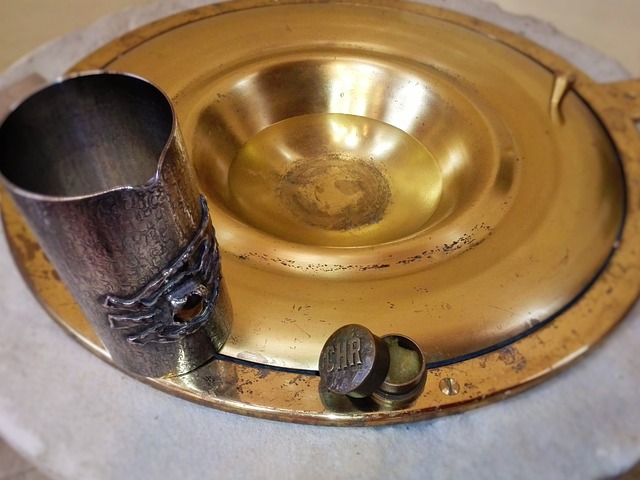Chrism in the Catholic Church is a consecrated oil used in various sacraments and liturgical rites. It is typically a mixture of olive oil and balsam, blessed by a bishop during the Chrism Mass on Holy Thursday. Chrism is used in the sacraments of Baptism, Confirmation, and Holy Orders, as well as in the consecration of churches and altars. It symbolizes the presence and power of the Holy Spirit in the life of the Church and the individual believer.
Table of Contents
Chrism: A Sacred Oil Used in Catholic Sacraments
Have you ever heard of the term “chrism” in the Catholic Church? If you’re not familiar with this sacred oil, don’t worry – you’re not alone. Chrism plays a significant role in various sacraments within the Catholic tradition, and its use dates back centuries. In this article, we’ll explore what chrism is, how it is made, and its importance in the Church.
Chrism is a special oil that is consecrated by a bishop during the Chrism Mass, which is typically held during Holy Week. This Mass is a solemn and sacred ceremony where the bishop blesses the oils that will be used throughout the year in various sacraments. Chrism is one of three oils that are blessed during this Mass, along with the Oil of Catechumens and the Oil of the Sick.
The process of making chrism is a meticulous one. The oil used is typically olive oil, which is mixed with a fragrant substance such as balsam. The mixture is then consecrated by the bishop, who prays over it and asks for God’s blessing upon the oil. This consecration imbues the chrism with a special spiritual significance, making it a powerful symbol of the presence of the Holy Spirit.
Chrism is used in several sacraments within the Catholic Church, most notably in the sacraments of Baptism, Confirmation, and Holy Orders. In Baptism, chrism is used to anoint the newly baptized person on the crown of the head, symbolizing their incorporation into the body of Christ. In Confirmation, chrism is used to anoint the forehead of the person being confirmed, sealing them with the gift of the Holy Spirit. And in Holy Orders, chrism is used to anoint the hands of the newly ordained priest, empowering them to carry out their ministry.
The use of chrism in these sacraments serves as a visible sign of the grace and power of the Holy Spirit at work in the lives of the faithful. It is a reminder of the presence of God in our lives and the call to live out our faith in a tangible way. The use of chrism also connects us to the long tradition of the Church, linking us to the generations of believers who have gone before us.
In addition to its use in sacraments, chrism is also used in the consecration of churches and altars. When a new church is dedicated, chrism is used to anoint the walls and altar, consecrating them for sacred use. This act of anointing symbolizes the setting apart of the church as a holy place, where the faithful gather to worship and encounter God.
Overall, chrism holds a special place in the Catholic Church as a sacred oil that is used in various sacraments and rituals. Its use serves as a powerful reminder of the presence of the Holy Spirit in our lives and the call to live out our faith in a visible way. So the next time you hear the term “chrism” mentioned in the context of the Church, you’ll have a better understanding of its significance and importance.
The Significance of Chrism in Catholic Rituals
Have you ever heard the term “chrism” being used in the Catholic Church and wondered what it means? Chrism plays a significant role in various rituals and sacraments within the Catholic faith. In this article, we will explore the meaning and significance of chrism in the Catholic Church.
Chrism is a sacred oil that is used in various sacraments and rituals within the Catholic Church. It is made up of a mixture of olive oil and balsam, which is a fragrant resin. The oil is consecrated by a bishop during the Chrism Mass, which is typically held on Holy Thursday. This special Mass is attended by priests, deacons, and members of the laity, and it is during this Mass that the chrism oil is blessed and consecrated for use throughout the year.
One of the most significant uses of chrism is during the sacrament of baptism. When a person is baptized in the Catholic Church, they are anointed with chrism on their forehead as a sign of their initiation into the Christian faith. This anointing symbolizes the sealing of the Holy Spirit upon the individual and marks them as a member of the Church.
Chrism is also used during the sacrament of confirmation. In this sacrament, individuals are anointed with chrism on their forehead by a bishop as a sign of their full initiation into the Church. This anointing is a powerful symbol of the gifts of the Holy Spirit that the individual receives during confirmation, empowering them to live out their faith in the world.
Another important use of chrism is during the sacrament of holy orders. When a man is ordained as a deacon, priest, or bishop in the Catholic Church, they are anointed with chrism on their hands. This anointing symbolizes the special grace and authority that they receive to carry out their ministry within the Church. It is a powerful reminder of the responsibility that comes with serving as a minister of the Gospel.
Chrism is also used during the sacrament of anointing of the sick. When a person is seriously ill or facing a major surgery, they can receive the sacrament of anointing of the sick, where a priest anoints them with chrism on their forehead and hands. This anointing is a sign of God’s healing presence and grace, offering comfort and strength to the individual in their time of need.
In addition to these sacraments, chrism is also used in the consecration of altars and churches. When a new church is dedicated or an altar is consecrated, chrism is used to anoint the altar and walls of the church as a sign of their dedication to God. This anointing symbolizes the sanctity of the space and sets it apart for worship and prayer.
Overall, chrism plays a vital role in the sacramental life of the Catholic Church. It is a powerful symbol of God’s presence and grace, marking significant moments in the lives of believers as they journey in faith. Whether it is used in baptism, confirmation, holy orders, anointing of the sick, or the dedication of churches, chrism serves as a tangible reminder of the spiritual blessings that we receive as members of the Body of Christ.
The History and Tradition of Chrism in the Catholic Church

Have you ever heard the term “chrism” being used in the Catholic Church and wondered what it means? Chrism plays a significant role in the traditions and rituals of the Catholic Church, and its history dates back centuries. In this article, we will explore the origins and significance of chrism in the Catholic Church.
Chrism is a sacred oil that is used in various sacraments and rituals within the Catholic Church. It is made by mixing olive oil with a fragrant substance, usually balsam, and is then consecrated by a bishop during a special ceremony called the Chrism Mass. This Mass is typically held during Holy Week, leading up to Easter Sunday, and is attended by priests, deacons, and members of the congregation.
The use of chrism in the Catholic Church can be traced back to the early days of Christianity. In the New Testament, we see references to the anointing of Jesus with oil by Mary Magdalene and the apostles. This act of anointing was seen as a symbol of consecration and blessing, and it became a common practice within the early Christian community.
Over time, the use of chrism became more formalized within the Church, and specific rituals were developed for its consecration and use. Today, chrism is used in several sacraments, including baptism, confirmation, and holy orders. In each of these sacraments, chrism plays a unique role in signifying the presence of the Holy Spirit and the individual’s commitment to their faith.
In the sacrament of baptism, chrism is used to anoint the newly baptized person as a sign of their initiation into the Christian community. This anointing is a symbol of cleansing and purification, as well as a mark of belonging to Christ. In confirmation, chrism is used to seal the candidate with the gift of the Holy Spirit, empowering them to live out their faith in the world.
In the sacrament of holy orders, chrism is used to anoint the hands of the newly ordained priest or deacon. This anointing symbolizes the priest’s authority to celebrate the sacraments and minister to the faithful. It is a powerful reminder of the priest’s role as a servant of God and the Church.
The use of chrism in these sacraments highlights the importance of tradition and ritual within the Catholic Church. These rituals connect us to the early Christians who first used chrism as a symbol of their faith and commitment to Christ. They remind us of the sacredness of our beliefs and the power of the Holy Spirit working within us.
As we participate in the sacraments and rituals of the Catholic Church, we are reminded of the deep roots of our faith and the generations of believers who have come before us. Chrism serves as a tangible reminder of our connection to this tradition and our commitment to living out our faith in the world.
So the next time you hear the word “chrism” being used in the Catholic Church, remember its rich history and significance. It is not just a simple oil, but a symbol of our faith and our connection to the larger Christian community. Let us embrace this tradition with reverence and gratitude, knowing that we are part of something much greater than ourselves.
How Chrism is Made and Blessed in the Catholic Church
Have you ever wondered what exactly is ‘chrism’ in the Catholic Church? Chrism is a special type of oil that is used in various sacraments and rituals within the Catholic tradition. It is a sacred substance that holds great significance in the faith, and its production and blessing are steeped in tradition and ritual.
The process of making chrism begins with the selection of high-quality olive oil. This oil is then mixed with a fragrant substance, usually balsam, which gives the chrism its distinctive scent. The mixture is then carefully blended together, ensuring that the ingredients are thoroughly combined.
Once the chrism has been prepared, it is then blessed by a bishop during a special ceremony known as the Chrism Mass. This Mass is typically held during Holy Week, the week leading up to Easter, and is attended by priests, deacons, and members of the laity.
During the Chrism Mass, the bishop blesses the chrism by invoking the Holy Spirit and asking for God’s blessing upon the oil. This blessing is a powerful moment in the ceremony, as it is believed to infuse the chrism with the grace and power of the Holy Spirit.
After the chrism has been blessed, it is then distributed to the various parishes within the diocese. The chrism is used in a number of sacraments and rituals, including baptism, confirmation, and ordination. It is also used in the anointing of the sick, a sacrament that offers healing and comfort to those who are ill or suffering.
The use of chrism in these sacraments and rituals is deeply symbolic. In baptism, for example, the chrism is used to anoint the newly baptized person, symbolizing their incorporation into the body of Christ. In confirmation, the chrism is used to seal the candidate with the gift of the Holy Spirit, empowering them to live out their faith in the world.
The anointing of the sick with chrism is a powerful moment of healing and grace. The oil is used to anoint the sick person, offering them strength and comfort in their time of need. It is a reminder of God’s presence and love, even in the midst of suffering.
Overall, chrism plays a vital role in the sacramental life of the Catholic Church. It is a sacred substance that is used to convey God’s grace and blessing to his people. The process of making and blessing chrism is a deeply symbolic and ritualistic practice, reflecting the rich traditions of the Catholic faith.
So the next time you witness the use of chrism in a sacrament or ritual, take a moment to reflect on the significance of this sacred substance. It is a tangible reminder of God’s presence and love in our lives, and a powerful symbol of our faith in action.
Exploring the Symbolism of Chrism in Catholic Liturgy
Have you ever heard the term “chrism” being used in the Catholic Church and wondered what it means? Chrism plays a significant role in Catholic liturgy and holds deep symbolism within the faith. In this article, we will explore the meaning and importance of chrism in the Catholic Church.
Chrism is a sacred oil that is used in various sacraments and rituals within the Catholic Church. It is made from a mixture of olive oil and balsam, which is a fragrant resin. The oil is consecrated by a bishop during the Chrism Mass, which is typically held on Holy Thursday. This special Mass is a time when priests from the diocese gather with their bishop to renew their commitment to their ministry and to receive the holy oils that will be used throughout the year.
The use of chrism in the Catholic Church dates back to ancient times and has deep roots in the Old Testament. In the Bible, we see references to the anointing of kings, priests, and prophets with oil as a sign of their consecration and empowerment by God. This tradition has been carried on in the Catholic Church through the use of chrism in the sacraments of Baptism, Confirmation, and Holy Orders.
In the sacrament of Baptism, chrism is used to anoint the newly baptized person on the crown of the head. This anointing symbolizes the sealing of the Holy Spirit upon the individual and their incorporation into the body of Christ. It is a sign of their new identity as a child of God and a member of the Church.
In the sacrament of Confirmation, chrism is used to anoint the forehead of the candidate. This anointing signifies the outpouring of the Holy Spirit upon the individual and their strengthening in the faith. It is a sign of their commitment to live out their baptismal promises and to be witnesses to the Gospel in the world.
In the sacrament of Holy Orders, chrism is used to anoint the hands of the newly ordained priest. This anointing symbolizes the priest’s consecration to serve the people of God and to celebrate the sacraments on behalf of the Church. It is a sign of their participation in the priesthood of Christ and their call to be shepherds of God’s flock.
The use of chrism in these sacraments highlights the importance of the Holy Spirit in the life of the Church and the individual believer. The anointing with chrism is a visible sign of the invisible grace that is at work in the sacraments, transforming and sanctifying those who receive them.
In conclusion, chrism is a sacred oil that holds deep symbolism in the Catholic Church. It is used in the sacraments of Baptism, Confirmation, and Holy Orders to signify the outpouring of the Holy Spirit and the consecration of individuals to their respective ministries. Through the use of chrism, the Church proclaims the presence and power of God at work in the lives of believers, empowering them to live out their faith in the world.
Conclusion
Chrism in the Catholic Church is a mixture of olive oil and balsam that is consecrated by a bishop during Holy Week. It is used in various sacraments, such as baptism, confirmation, and ordination, to signify the presence of the Holy Spirit. The use of chrism dates back to the early Church and continues to hold significant importance in Catholic liturgical practices.


